#history nerdery
Explore tagged Tumblr posts
Text
So I've been reading Hidden Histories by Mary-Ann Ochota (highly recommended if you are in the UK and want to be able find out some cool historical/archaeological stuff wherever you go) and it includes a picture of something that blew my mind.

[Image from Wikimedia Commons]
This is John Ogilby's 1675 strip map showing the route from London to Land's End, from the point of view of the traveler. It doesn't show great swathes of the surrounding area - just as much as you need to be sure of your bearings and follow the route. You'll notice each strip has its own compass rose and is at a slightly different orientation - that's because each strip is aligned with the direction of travel along the road, not with a compass point.
In other words, as Hidden Histories points out, it's a 17th century satnav. Isn't that just the coolest thing?
Idk maybe I'm just a nerd but it reminds me of seeing the remains of a (possible?) street food stall in Pompei, or seeing the Honorius pendant at Sutton Hoo where somebody much later had put a Roman coin on a pendant and worn it - just like the replica Roman coin pendants I used to buy in museum gift shops as a kid. The past is a foreign country, but maybe it's not so different after all.
5 notes
·
View notes
Text
If I encounter ONE more person on three internet misinterpreting etymology of the word 'Machiavellian' I swear I am going to reach through my screen and beat them to death with my own copy of The Prince
#hint it has NOTHING to do with the book#just go fucking read it#it's still in print#it's not a long book#history nerdery#linguistics#linguistic nerdery
3 notes
·
View notes
Text
TFW...(art history nerd alert)
Ok so, recently I've been playing through AC Syndicate (I know I'm years behind the curve) and came across this artwork in the course of a story mission
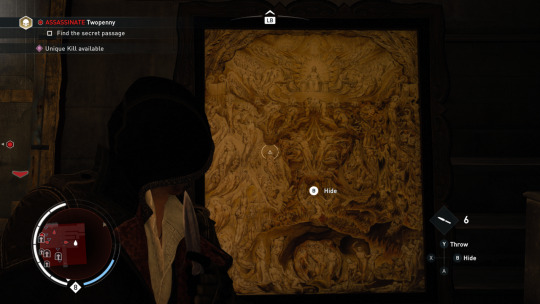
Only, I KNOW THIS PIECE! This is William Blake's A Vision of the Last Judgement
And I know that because for several years I was part of the team that cared for it! This piece of nowhere near this big, and whilst it's use is ironic (you can hide behind it in order to assassinate your target) it's a weird feeling to see something you know so well featured in pop culture....
#this has twisted my melon#ask me for more details#I have sources!#william blake#art history nerdry#history nerdery#art history#conservation#there are benefits to working in heritage#apparently
0 notes
Text
One of my favourite bits of linguistic trivia is that in Ancient Greek, the word ἰχώρ (cognate to the modern English "ichor") is attested in extant literature to mean both "the bodily fluid which gods possess instead of blood", and also "gravy", which implies several things about Ancient Greek culinary culture's attitude toward gravy.
#language#linguistics#word nerdery#history#classics#ancient greece#food mention#or alternatively several things about gods
8K notes
·
View notes
Text
So I in the year 2024 managed to overcome my various social difficulties in order to visit a local pub and watch the 6 nations also and ordered food whist there. However, when said food came I was provided with a spoon and a steak knife rather than the expected knife and fork.
Forgive me for not realising I was a time traveller who'd obviously landed in the pre-renaissance era. Please excuse me whilst I freak out the rest of the patronage by using a fork!
#history#history nerdery#rant#sorry for the rant#very british problems#british problems#the uniquely british experience of a wetherspoons#british stuff
0 notes
Text
Tell me you have no idea about British history and ecology without telling me you have no idea about British history and or ecology.....
LISTEN HERE YOU LITTLE FUCKWIT!!
Most large predators (bears and big cats) in the British Isles went extinct around the last ice age (you know when it was covered in several miles of ice) because there simply wasn't enough food to support them (or at least not a healthy breeding population). The only large predators to survive that period to actually get hunted to extiction were a wolves (and arguably boars). Which of course were living in a tiny area with very few large herbivores (e.g. bison, buffalo etc.) outside of domestic livestock to provide them with prey. What this meant was that their population was easy to hunt to extiction without that being the actual intention.
Widespread deforestation only began in the bronze age (combined with the introduction of permanent agriculture) and reached it's peak in the 16th-19th centuries (due to increasing population size and the demand for wood for charcoal to supply metal production and shipbuilding) and was linked to the introduction of calorie dense crops (like potatoes) which it turned out grew particularly well in the cold and damp conditions we live in allowing the population growth that happened.
The UK also retains the world's largest temperate rainforest and created the world's first marine reserve (and we have one of the most heavily protected coastlines in the world). Most of the biodiversity loss which Britain has experienced has happened in the last 200ish years and of that, especially what's been caused by changing agricultural practices is because of the adoption of intensive farming practices in an effort to compete with cheap imports from the US and Canada and latterly Australia (where a lot more land can be cultivated or used for farming).

Actually your society is the freaks for shooting everything that moves and burning half your "nature reserves" every year so that upperclass dandies can eat leaded pheasant. North Americans are the well adjusted ones here, your country has become a desolate suburban lawn in island form
#environment#history nerdery#environmental history#uk history#Americans remain uninformed about the rest of the world
100K notes
·
View notes
Text
A Visit to the Homeland of Ufotable
This is the start of a long, collaborative post with Reichel about a little adventure we took (no, not the adventure to USJ—that post is coming eventually, really!). Spoiler alert: this is an Ufotable adventure! I’m preparing the history stuff, so @reicchel, take it from here!
#more posts coming!#kny in real life#there shall be nerdery#of both the history and culture kind and the fangirl kind#the 2024 joint mission thru japan#tokushima mission
35 notes
·
View notes
Text
In the native dialect of Lesbos, Sappho's name is spelled "Psappho". I sometimes picture what it would have been like if that had been the spelling modern English had gone with. Imagine being psapphic.
11K notes
·
View notes
Text
5/30 The pseudohistory of Prometheus
(Previous) | (Index) | (Next)
⛬
We return to a movie I wish to send on a journey down the Kola Superdeep Borehole, Prometheus.
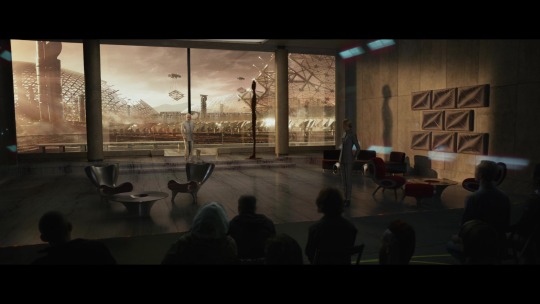
And my insanity truly begins in this segment. We are only 1/10th of the way through the movie so far. Content warnings for discussion of racism in pseudoscience and historical anthropology, Spider getting hung up on logistics and space nerd stuff, and pictures of Yuri Knorozov, the most sour-faced man to ever live.
The cast sits down for a briefing. This is a scene with an easily identifiable narrative function: providing exposition to the theater audience. The act of doing a briefing makes sense. It is the last thing here that will.
We are introduced to a hologram of Peter Weyland, the financier of the expedition. The name means all sorts of Lore to the series, but what’s intensely distracting is that we seem to have caught Weyland halfway through applying his zombie makeup.

Weyland is played by Guy Pierce. As of the filming of this movie, he was somewhere around 45 years old. Yes, they smothered this Australian in old man drag so that he could play this character. This is a baffling decision, that only gets slightly less baffling if you know the production history of the movie, which I did not at the time.
youtube
Guy Pierce was hired to play a younger Peter Weyland. There’s a promo video out there of him giving a fictional TED Talk in the not-to-distant future of next Sunday AD 2023, there were various plans for him to appear in the movie proper. None of those scenes are actually in the movie. They refused to double-cast the role for some reason. While the practical effects in the movie are generally excellent and it does make the tiniest smidge of sense that a hypercapitalist asshole would be portrayed as a literal rubber-faced movie monster, this, like many things in Prometheus, made the movie a very weird sit. One where I was increasingly less open to going along with the movie’s fiction. You are telling me that this is an actual human man. I am not buying it. He looks far less human than David, the only non-human there.
Speaking of David, Weyland calls him “the closest thing to a son I will ever have”, and then immediately says David is an inhuman lesser being, who does not appreciate the specialness of his existence because he does not have a soul.

Which is funny, because I think you can see David’s soul leaving his body at this exact moment.
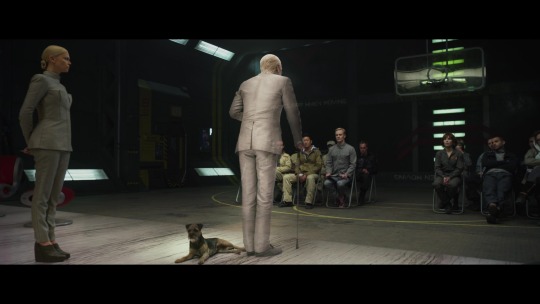
Weyland then tries to mash in some existential weight to the movie: they might finally get an answer for “why are we here?” and all that jazz! He also tries to explain why naming a ship Prometheus is totally not like calling it Titanic II: Don’t think about the part of the myth where Prometheus is chained to a rock and has his ever-regenerating liver eaten by an eagle every day! Think about the bit where he brought fire to mankind! We’re gonna bring back that bit!

And then the archaeologists take over the briefing, and this, THIS, is the bit where they entirely lost me. My suspension of disbelief had already been strained by multiple oddities up to this point. My skepticism about these characters in particular was already a bit elevated by their implied invocation of the ancient astronauts concept.
Turns out, only Vickers, Shaw, and Holloway know why they’re here.
Two years away from Earth. On a massively expensive expedition that intends to make first contact with an alien culture, the first alien culture that humankind has ever found evidence of. Nobody has been briefed up until this point.
This is lunacy.
Explanations have been figured out by fans since then: this is a passion project by Weyland, an annoyance to the rest of the corporate structure that nobody else believes in. The movie eventually intimates this, through Vickers.
Fans have thus speculated that Weyland was just quarantined off to do his little alien hunt, with no logistical support that would make it actually functional. He believed a crazy theory put forward by Shaw and Holloway, and everyone else wasn’t actually best-of-the-best, they were just whoever would take a big paycheck to do fuck-all for nearly five years of sleeping their way to and from their destination.
I am willing to consider that this was intentional. The movie possibly tries to confirm this with Mr. “I’m here for the money” Fifield, but none of the other characters have enough characterization to determine if this is the general trend.

How could we make a story that more clearly spells this out? Maybe Millburn the biologist could encounter more of the crew talking about the payout from taking the job, or reveal that he himself has some project he needs money for. It would also chip away at the dearth of character-building dialog for most of the cast.
As a result of those deficiencies in characterization, a lot of my discussion of plot points is going to be focused around what they do, rather than why. …Except when it is about the why, at which point the main commentary will be “WHY.”
In any case: while it makes sense, I'm still not certain the film meant for this character motivation. Prometheus is just so loudly explicit with so many of its plot points that it doesn’t seem like this is the case. The movie certainly believes in the sincerity and correctness of the archaeologists, though.
Unfortunately, it also immediately tells me that they’re a couple of wingnuts. I’m not sure if it intends to, for reasons I’ll get into after I foam at the mouth for a little while.
They present a series of artifacts to the crew: Egyptian, Mayan, Akkadian, Sumerian, Hittite, Hawaiian, and their Scottish cave painting. All of them feature “men worshiping giant beings”, who are pointing to what stargazer nerds call an asterism: a pattern of stars. Shaw and Holloway believe that these are aliens that engineered humans into their current state. Shaw literally says “it’s what I choose to believe” as the entirety of their justification for this.
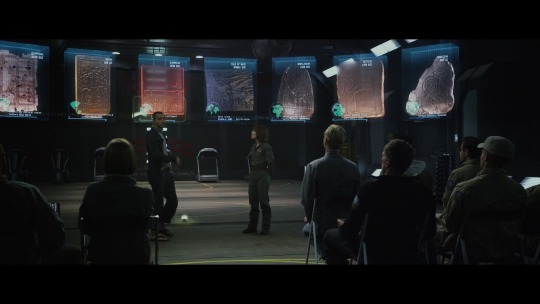
Again: I knew the movie wanted me to take this as truth, within its universe. That’s the implicit deal the movie has made with the audience, this is truth. You are supposed to be contemplating the "whys" of it all. But the movie had also smacked me in the brain so many times in the past five minutes, that I, like Millburn the Biologist, was ready to call bullshit.
I appreciate him for doing so, and it shows he could have been a smart character, but sadly, he is in Prometheus.

Because he is a fictional biologist and I am an actual biologist, I will expand on his argument, as I descend into ranting for the rest of the post.
Millburn objects on the basis of evolutionary history, which the movie only partially succeeds in papering over: the implication is that evolution on Earth was directed with the deterministic outcome of creating something like humans.
This opens up a whole new can of worms that the movie doesn’t get into–when exactly did this engineering start? When great apes evolved? When mammals did? Tetrapods? Skeletons? DNA itself? After all, we know the aliens, now dubbed Engineers by the archaeologists, have DNA. Did they seed all life on Earth? How did they evolve? Our last universal common ancestor is believed to have already been using DNA 3-4 billion years ago, evolving out of a likely RNA-based genetic standard. Hominins diverged from other apes around 15-25 million years ago. What sort of culture would undertake a project that required at least 15 million years on the extreme low end?
All excellent questions! The movie is not concerned with them. I am, and that is part of why this movie still lives in a special, awful place in my head.
This isn’t actually what made me become actively hostile toward the archaeologists, though. What managed that, well! It was their archaeology. Anybody who had an Ancient Egypt Phase in their childhood should be able to articulate multiple reasons why the academic community would’ve laughed these guys out of the building.

Bigness in ancient egyptian art does not indicate literal size. It indicates importance. In fact, the artifacts the movie uses exclusively come from artistic traditions which feature hierarchical or non-literal scale. Do the Engineers turn out to actually be eight feet tall? Yes! Am I still annoyed by this? ABSOLUTELY.
You know what else is a big problem? Many of the cultures they reference here had written language! A LOT of written language! They include Egyptian, Sumerian, Babylonian, and Mayan art in their evidence, all of which not only wrote a LOT of things down, but had a habit of annotating a lot of their art with labels to tell you what was going on! You can actually see some on the props they used in this scene!
Beyond that, they had very prescribed formal styles, where you can follow the action entirely through gestures, held objects, attendant symbols, and clothing! If all these cultures, as implied, had actual, direct contact with aliens, recorded in the art presented here, we would know what they were told.

Skipping ahead of the movie for a minute: the Engineers were apparently not telling humans “we’re here in these stars, come find us”, they were telling humans “settle the fuck down or this is where the hurt’s going to come from”.
Here's the thing. Ancient peoples weren't stupid. They wouldn't just not talk about this. If giant aliens came down from the sky and gave them a stern talking-to that contradicted their religion, that would be a big deal. And these characters specifically say the Engineers are being "worshiped" in these images! They're apparently taking onboard what's being said!
It is certainly possible for information to be lost. Over long time scales, that's unfortunately the rule, rather than the exception. But again: half the artifacts have writing on them!
I chose to believe that Shaw and Holloway simply did not attempt to read any available translations of attendant texts, and they were thus cursed for their foolishness by the ghosts of Mayan Studies pioneer Yuri Knorozov and Egyptologist Jean-François Champollion, and the still-extant spirit of Assyriologist Irving Finkel.



Knorozov knows your sins against Mayan Studies. Knorozov is a vengeful god. Chapollion and Finkel are likewise very cross.
Two last things stood out to me in the theater. One of them was extremely petty but tied into some very serious issues with pseudoscience, and the other one was not.
Pettiness first: the asterism shown in the artifacts is a pattern of six stars. The movie wants you to believe that it is very spooky that the only asterism that precisely matches this pattern are six stars that are too faint to see with the naked eye. This is laughable, both because the asterism is so generic-looking that I can think of several very visible asterisms that are good matches for the pattern, but it also recapitulates a bunch of really fucking annoying stuff from pseudoscientific bullshit.
First: Pseudoscience and pseudohistory likes to make a big deal out of the fact that every culture has stories about the stars. Why?
The sky is very important to every culture’s mythology, because every culture can see the sky. Like, that’s literally it. People can see the sky. They tell stories about it. There’s not much to do at night except look at the sky, when even keeping a fire lit can be an expensive prospect. It is not even the least bit weird when multiple cultures–all of them in the northern hemisphere in this case!–have stories about the same stars.
Second: Cultures varied in their ability to faithfully reproduce celestial landmarks in art and align their architecture, and were not as exact as modern techniques can manage. Pseudoscience will claim that they are exact, when it fits their pre-existing theory, or fudge the difference if they want something to fit their claims.
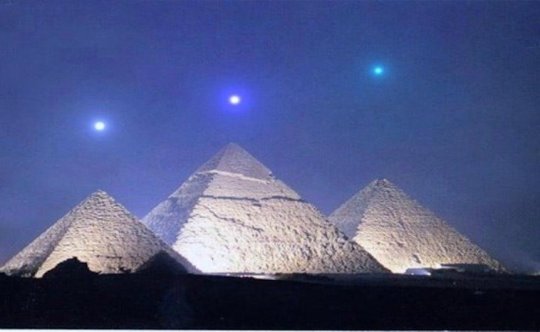
(This is a photoshopped image, by the way.)
Were the stone age temples of Malta secretly aligned with a particular star that foretold the doom of Atlantis, precisely tracking its location through the sky over thousands of years of Earth’s axial wobbling? No! They were roughly aligned with the sun. Sunlight is important when you don’t have electric lights. Were the Great Pyramids of Giza laid out ten thousand years ago to match the layout of the stars in Orion’s Belt, according to the designs of a legendary lost race of highly advanced non-African people? Were they tapping into the Earth’s magnetic field to generate energy? No! They were aligned with the cardinal directions, and they got them a bit wrong!
Hell, if we want to play at that game, I found a decent match for the asterism in Stellarium's Egyptian constellation set. Just flip this 90 degrees clockwise and you'll see I'm totally right. Aliens confirmed.

I know the movie is trying to tell me that all the asterisms in the art are precise matches for each other and are thus impossible to explain without intercultural contact (or aliens!!), but it is also showing me that they are not that precise. So, it’s just showing me stars. At least in some of them. Their little charcoal lad from the Isle of Skye may be throwing fruit at his audience.
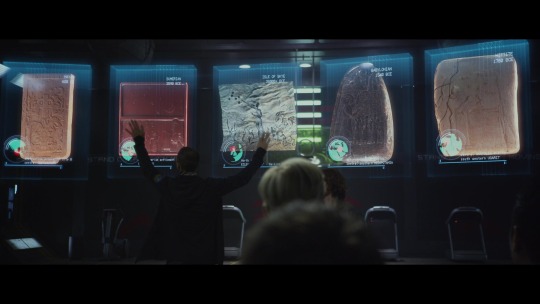

In fact, there's a further, probably unintentional link to pseudohistorical claims in the artifacts presented: the Maya artifact shown does not actually depict a "giant figure" being worshiped, in fact, it shows one instantly recognizable, known figure in Classical Maya history: It is an altered version of the ornately carved coffin lid of Kʼinich Janaab Pakal I (24 March 603 - 29 August 683), with the top quarter of the carving replaced with a star pattern that looks nothing like the ones on the other artifacts.
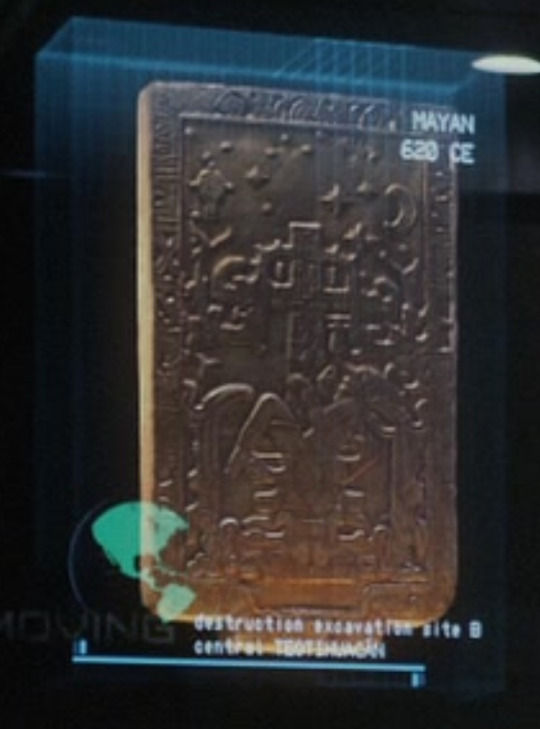
The carving shows Pakal in the pose of an infant, entering into death and being reborn. It is packed full of so many symbolic elements that can be easily recognized by those more familiar with the Classical Maya than I am.
Conspiracy theorist Erich von Däniken thought that it showed Pakal rocketing away on a spaceship. Däniken proposed this because he didn't understand the cultural symbolism, but he had seen pictures of astronauts before.
And on that note, 2,400 words into this rant, we get to the actually bad shit. Unfortunately, it ties into the issue I had with the premise to begin with: the real-world context of pseudoscientific claims of ancient alien contact. Specifically, the racism.
We’re going to unspool this more near the end of the movie, because there was further behind the scenes I was not aware of when I first saw Prometheus, and it just compounds this stuff.
So, when I went on my first tangent on how unpleasant ancient alien theories are, one thing I highlighted is that the further from Western Civilization you get, the more these theories presuppose that fellow humans are incapable of building great works or imagining interesting things. No, they had to be guided, and explicitly shown things that they copied down to the best of their limited capability.
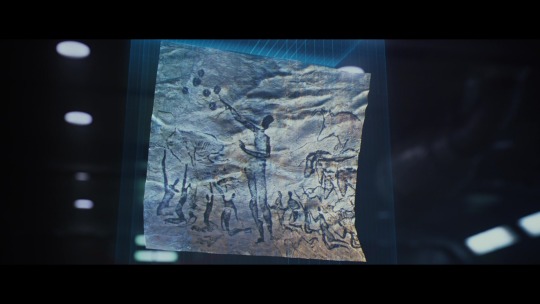
The only european example of alien contact they show is from the Upper Paleolithic, 37,000 years ago. All the examples around the Mediterranean and Mesopotamia range from 5,500-3,700 years ago. The examples from the Classical Maya and Hawaiʻi are from 620 and 680 CE.

During this period, Tang Dynasty merchants were creating the first paper money as the famous female emperor Wu Zetian was on her way to the throne. The Prophet Muhammad went to al-Aqsa mosque, and we’re only eight years before the birth of Charlemagne’s grandfather. We’re no longer talking ancient, it’s just old.
I want to emphasize that the movie is presenting these not as depictions of myths that have been passed down–though there are more problems with that I’ll get into shortly–these are implied to be contemporary depictions of events witnessed by the artists, who were quite possibly instructed by the Engineers to record a precise pattern of stars. An equivalency is being drawn between stone age Europe, bronze age Africa and the Middle East, and a couple of startlingly recent Mesoamerican and Polynesian cultures.
But let’s be generous. Maybe these aren’t supposed to be contemporary accounts in these two outlier cases: the movie’s script will certainly indicate later that they have no idea what they’ve implied here. Perhaps these are story traditions that were handed down from the Olmecs and Melanesian precursors of the first to sail to Hawaiʻi.
Unfortunately, this just recapitulates a different racist trope: that European and more “developed” civilizations invented so much cool and comfortable material culture and philosophy that they forgot the Mystical Religious Truths of the old ways, which were preserved only in Primitive Lands and among Uneducated Peoples, where they never found anything better to do with their time. Oh, if only we had heeded the warnings from those spiritually attuned non-white people!
youtube
(Look, I only remember Devil (2010), which has 50% on Rotten Tomatoes, because M Night Shyamalan wrote and produced it, and this was two years after The Happening came out, so I watched it out of morbid curiosity. It's not as unbelievably bad as The Happening, but as shown in the clip above, the spiritually attuned latino security guard Ramirez attributes toast landing jelly side down to Satan. That is an actual thing that happens in the movie. He is proven right.)
But let's be even more generous: someone probably realized that they'd focused near-exclusively on Middle Eastern cultures, and wanted to throw in a couple from elsewhere. Sitting here, having seen the movie in full, this is the most likely option: their inclusion creates a contradiction with a later scene, and was thus probably not checked for consistency. These cultures were thrown in as a bit of background flavor. I list this last, because in the theater, there was no way to know this at the time.
That answer's still not great. Still leaves us in the same position, where Europeans are pretty much given their own agency, while other cultures need to be led.
Oh, and to anyone else who’s made it this far and knows the production history of Prometheus: don’t worry! I know what Ridley Scott told that one interviewer, about a contact between a less-ancient European power and the Engineers. I’m saving that one. I like to save that one, because strategic deployment of that quote made some of my IRL friends scream.
Next time: the Prometheus descends to an alien world, and I descend further into madness. I am going to drag you all down with me.

(Pictured: Yuri Knorozov, and my present mood.)
⛬
(Previous) | (Index) | (Next)
⛬
Citations for alt text ramblings:
https://www.almendron.com/artehistoria/arte/culturas/egyptian-art-in-age-of-the-pyramids/catalogue-fourth-dynasty/
#Prometheus (2012)#prometheus 2012#The last time I watched this movie with a scientific colleague and friend#this scene took us twenty minutes to get through#because we were both biologists#plus me with the archaeology and a dash of space nerdery#and they knew mesopotamian history#so by the time we were done with this scene we were ginned up and ready to fight the movie
71 notes
·
View notes
Text
I need to do. Fandom stats
#comparisons on which tags are more popular for the different pairings with my blorbos#because pairings are almost fandoms of their own#especially when the blorbo has like a decade+ of fandom history and had different eras with different characteristisation & context#wow i have a ramble tag now#fandom nerdery
8 notes
·
View notes
Note
Did you immediately recognize those old obscure DC villains from the old toy set, or did you somehow look them up really quickly?
I recognized the Key and Johnny Thunder immediately, the others I did not.
J. Thunder is a D-lister, so that's no big feat, and the Key got some event BS in the past 2 decades as I recall, and the comic shop I used to work at had a copy of JLA 41 on the wall, I saw it every day.
I found Mouse-Man with a search for "DC Mouse villain" early in.
I found Key Master's intro issue in a cover gallery online, and that lead me to Brainstorm and Johnny Thunder's covers. Realizing everything was in an early-to-mid '65 range, I started checking cover galleries for the involved characters until I found the Aquaman creature.
If the robot was from the same time period, it was either on a Flash cover (I couldn't find a complete 1960s the Flash cover gallery) or was inside one of the books.
The identical sculpt style and the very "tail-end-golden-age" DC look of the other characters made me immediately suspect they weren't re-uses from generic lines. Generic superhero stuff in that format tended to follow a more knock-offy look, like with these Tim-Mee "honest, that's not Thor and Doctor Doom" figs.
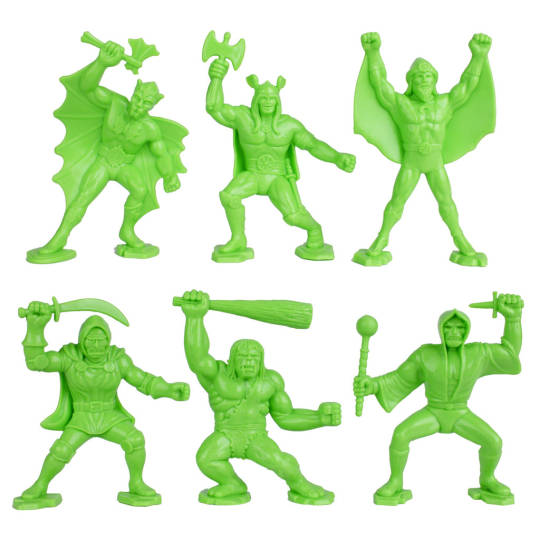
The Aquaman critter would fit in with generic monster figurines of the time, but as odd as it sounds, "Mouse Man with a Syringe" was a little too period-comics-accurate to read as generic.
3 notes
·
View notes
Text
When did "intersex", as in the word "intersex", enter common parlance? I was skimming thru my high school diary a while ago and came across the sentence "whether man, woman, or [outdated word for intersex people starting with H]" and like obvs I was trying to be inclusive to the notion but if "intersex" was the term du jour by then I didn't know it
This isn't me self-flaggelating for being cringe and unwoke btw, I only knew the existence of such people–despite an Indiana public school education that would have preferred I never knew there was anything outside a absolute division of Man™️ and Woman™️–as that word fifteen years ago, just curious if the word "intersex" was already established and preferred by then and it just hadn't made its way to Indiana high schools yet
#apples and oranges but exceptional-to-the-norm fruit but. that would have also been the year i found out about the genderqueerness#don't remember if it was before or after that entry tho i don't think i ever wrote the genderqueer thing down until after high school#intersex history#word nerdery
4 notes
·
View notes
Text
Have to jump in here as a historian, but I suspect the reason may well be that corsets and binders (as I understand it) are designed to do different things.
The basic idea of a corset is to support the female lady breasticles and stop the wearer from breasting boobily (the compression forces more of the soft tissues in the middrift under the breasts, and the boning works the same way as the underwire in a brasserie to provide shape), hence why every woman in a costume drama wearing a low cut dress has a cleavage you could ski down. However, binders (AFAIK) are designed to compress the chest and remove the physical evidence of the wearer's breasticles, and work more like male corsets which are longer and encompass more of the torso (the vanity aspect is that wearing one makes you look slimmer/more broad chested by hiding your gut (ask any man to suck his in and you'll see the effect)).
The oft reported deformation of the ribs and displacement of the organs caused by corsets only really happens when you're wearing a tight laced one for hours on end (as in reducing your waistline beyond 6 inches (up to 4 inches off your waistline is generally the recommended amount) for 10 hours a day over several months or more).
THINGS I NEED TO FUCKING KNOW: Why every fuckin trans man or nb person I know who binds is like “oh binders are the worst, you can’t breathe in them, I know someone who broke a rib once”,
And meanwhile over in historical costuming, we are fucking eating, sleeping, swordfighting, riding horses, and feeling great like this:

(credit: Jenny La Flamme, The Tudor Tailor, Verdaera)
Like is there NO overlap between people who want to bind and people who care about accurate 16th century clothing reconstruction techniques?
(I, okay, maybe it is kind of a niche interest, but…. REALLY? Anyone who’s made a boned binder, PLS SPEAK TO ME)
Keep reading
#obviously if your corset/binder is painful that's a bad sign#usually because it's either too tight or badly fitted#or you're wearing it too much#queer shit#lgbtqia#lgbtq community#queer tumblr#lgbtqia pride#trans stuff#history nerdery#trans masc#important information#corsetry
69K notes
·
View notes
Text
Y'know...
I've recently had this burning inclination to grow through every piece of writing I've ever made, find every instance I've ever used the word 'destroyer', and change it to... something I'll have to come up with. For consistency's sake. Or something. Holy crap that would be stupid. I'm not doing it. Absolutely not---
#The actual reason is that there's some important historical background behind the word 'Destroyer" in the naval context#which very specifically is not one for one with what happens in the 12 Worlds#[If anyone wants to know what that background is please hit me up I'm dying to release this nerdery]#So#Like my use of the term 'armtrack' instead of 'tank'#In theory I should come up with a substitute with its own background and history rooted in the 'lore' of the 12 Worlds#I shall save this for another time hopefully having forgotten this debate with myself ever took place
0 notes
Text
Why set Dracula: 2004 in 2004?

Earlier this week, we revealed that our next project will be Dracula: 2004, an exciting new adaptation of Bram Stoker’s Dracula set in the early Noughties. But the question is, why 2004? It can’t just be for Britney Spears, right?
Well, as much as I love Britney Spears, she’s not the only reason I chose the year 2004 as the setting for this version of Dracula. If you want to read a 1,500 word (!) essay on the advancement of technology, the themes of gothic literature, and why I love Dracula, then you’re in the right place. Buckle in for an outpouring of English-teacher-nerdery (yes, I really am an English teacher in real life!) and prepare to be lectured to.
The thing about Dracula is that it’s already been done to death (pun unintended) a thousand times. You’ve got the classic gore of Hammer Horror; the Ye Olde Copyright Issues of Nosferatu; the romance of Coppola’s remake; the odd (but strangely compelling) Van Helsing, starring Hugh Jackman; and more recently, Renfield and Last Voyage of the Demeter. And that’s not even broaching the world of audio fiction, with Murray Mysteries, RE. Dracula, Dracula: The Danse Macabre and The Holmwood Foundation, all of which came out (or are coming out soon) within the past five years. The point is, the market is absolutely swimming with vampires. We’ve got piles of absolutely fantastic vampire fiction coming out of our ears, even only focusing on Dracula content. So why the hell am I making more?
Well, firstly, I am personally of the belief that you can’t have too much of a good thing. I am a particular fan of the “two cakes” metaphor (pictured below) for the precise reason that there is almost certainly a nerd out there who, like me, will look at yet another Dracula audio drama out there and think “Two cakes!” If you are that person, then congratulations: you are my target audience!

(Image credit to Tumblr user @stuffman)
Secondly, most of the settings for Dracula adaptations appear to fit into one of two settings: original time period, or thereabouts (thinking of Danse Macabre here) or modern day (such as Murray Mysteries). To be absolutely clear, I adore these shows and am not in any way criticising them! But when I was rereading Dracula back in 2022, it occurred to me that there was an untapped market: 2000s nostalgia.
Ah, the smell of hair that has been aggressively hairsprayed and backcombed within an inch of its life! The sheer impracticality of wearing a dress over jeans, and doing it anyway just because it looked cool! The technological gleam of the Blackberry phone’s 5000 different keys, ready to incomprehensibly speed-text at a moment’s notice!
Most people are either old enough to remember this, or young enough to want to. The Noughties were an absolutely fascinating time period, one that many people look back on with a certain degree of fondness (especially considering the current state of the world). It also happens to bear a striking resemblance to the late 19th century, for reasons I am about to explain.
Bram Stoker first published his horror novel Dracula in 1897. At this point in history, Britain was a global powerhouse, having colonised half the world and with the British Empire at its height (and, many would argue, at its worst). Stoker explores one of the contemporary anxieties of the British public in great detail: the fear of the Other. While this is a common theme in most Gothic fiction, Stoker characterises the Other through the villainous Count Dracula, a man from the “uncivilised” Eastern Europe who (literally) drains dry the "honourable" people of Britain, taking advantage of their kindness and generosity. He even goes so far as to “invade” the very island, proceeding to torment and prey upon innocent women, and must be driven back and killed by the "noble" British (and Dutch/American) protagonists. Count Dracula could be said to represent the contemporary British fear that the people they had colonised and exploited would turn on them and thus invade their country.
In 2004, Britain was at war with both Afghanistan and Iraq. This involvement in global politics – particularly so soon after 9/11, in 2001 – resulted in public backlash from multiple directions. Immigration was a topical issue: many Brits rejected the notion of refugees seeking asylum in the UK after escaping these war zones, viewing it as an “invasion” (sadly, not much seems to have changed here). This same disconnect between cause and effect is present in both the public of 1897 and 2004, particularly in the treatment of Roma people (although we have taken a detour away from Stoker's more unpalatable views on this topic).
But British politics are not the only connections we can draw between these two time periods. One of the key Gothic themes is science and technology versus religion and belief, and this theme is very heavily explored throughout Dracula, particularly through the character of Van Helsing. Bram Stoker would have been alive to experience ground-breaking inventions such as the traffic light, the telephone, the lightbulb, the steam turbine and fingerprint classification, all before Dracula was even written. With scientists and engineers learning how to play God at every turn, was it any wonder that authors of Gothic literature were inspired to explore this contrast, in other works like Dr. Jekyll and Mr. Hyde, or Frankenstein?
Similarly, 2004 was a time of exciting innovation, particularly relating to communication (a major motif in Dracula!). Not only was it in the thick of the early digital age, where internet access was fast-becoming universal and most people could now afford to carry a mobile phone, but it also signified the beginning of the social media era: Facebook was in development that year, and Myspace was gaining more users by the day. If you could go back in time and explain to your younger self the sheer scope of impact that social media would one day have on the world, would they believe you?
The sheer, terrifying enormity of change that occurred in both of these eras simply cannot be understated. In my opinion, there’s a reason that Buffy was so popular in the 90s and why Twilight burst into life only a few years later: change brings fear of modernity, fear of modernity brings a craving for tradition, and a craving for tradition needs monsters to feed it. I have altered some of the religions of the core cast in order to better reflect a more diverse modern society (there’s a whole different essay to be written on that choice alone) but the principle stays the same: with light comes shadows.
But wait, there’s more! One key reason why I selected 2004, of all the years, as a setting relates sharply to the social issues of Stoker’s time that I felt could not be adequately explored in a more modern Britain. In 1895, Stoker’s contemporary and acquaintance Oscar Wilde was imprisoned for gross indecency (relating to homosexuality), and one month later, Stoker began to write Dracula. Stoker – possibly to protect his own public image – condemned Wilde and ceased contact with him, but it’s plausible that Wilde’s influence remains within the character of Count Dracula.
Certainly, despite Stoker portraying the Count as a villain, who takes advantage of poor Jonathan Harker, he also writes the strangely possessive line “This man belongs to me!” when the three female vampires attempt to seduce Jonathan (and drain him). Count Dracula is both a man to be feared and repelled by… but also attracted to, a conundrum that Stoker (who many theorise to have been a closeted queer man) would have been intimately familiar with.
This brings us back to 2004, the year after Section 28 was repealed. For those of you who don’t know, Section 28 was first implemented by the UK’s Conservative government in 1988, and prohibited the promotion of homosexuality by local authorities. This meant, for example, that teachers weren’t allowed to teach children that being gay was normal and acceptable – they could acknowledge that queer people existed, but were not allowed to frame it positively. While it wasn’t illegal to be gay – and after 2003, it was even legal to promote it – it was still highly stigmatised in the UK, and many people were forced to remain closeted, similar to Wilde and his friends. Sexual repression is a substantial theme of Gothic literature and one that I very much wanted to explore in this adaptation, so I chose this era to reflect the concentrated and systemic efforts to suppress the presence of queer and trans people in the UK.
TLDR: To summarise, I chose the year 2004 as the setting for Dracula: 2004 because I felt that this era poetically reflected Stoker’s own – especially in the areas of global politics, technological innovation and societal repression of homosexuality – and felt that this would be the perfect era to explore some of Gothic literature’s most exciting themes: fear of the Other, science vs religion, and sexual repression. Additionally, 90s/00s music is FIRE and I also really wanted to get a Buffy reference in there. So sue me.
Dracula: 2004 will begin crowdfunding in April 2025! Keep your eyes on our social media for updates.
Care to take a bite?
#Dracula: 2004#dracula#dracula daily#bram stokers dracula#count dracula#audio drama sunday#podcast recs#audio drama recs#gothic literature#gothic themes#nosferatu#murray mysteries#re dracula#dracula the danse macabre#dtdm#the holmwood foundation#renfield#last voyage of the demeter#essay#classical literature#2000s#2000s emo#2000s nostalgia#2000s aesthetic#early 2000s
71 notes
·
View notes
Note
FASCINATING The cheese fascination is valid because cheese is DIVINE
I would like to hear about some of the "other festive cheese-begging traditions", if you don't mind.
You have very much come to the right blog, my friend.
Okay so there are a few, scattered about the country; as with the Mari Lwyd, I will stress that once again we are a touch thin on the ground for primary sources because this is Welsh folk culture, and as such, it was rarely actually recorded for the same reason that there is probably not a Wikipedia article on why a sizeable chunk of the population puts their pyjamas on when they get home from work. It is Just A Thing We Do. Why mention it? No one cares.
Sadly, it leaves us with a bit of a gap in our knowledge of things like our festive cheese-begging traditions; but, allow me to tell you some things we know.
So to start: why cheese?
In its employment of the myth to preach a sermon, and in its introduction of cheese, this version of the legend is very Welsh indeed. The extent to which cheese figures in Cambrian folk-lore is surprising; cheese is encountered in every sort of fairy company; you actually meet cheese in the Mabinogion, along with the most romantic forms of beauty known in story. And herein again is illustrated Shakespeare’s accurate knowledge of the Cambrian goblins. Heaven defend me from that Welsh fairy!’ says Falstaff, ‘lest he transform me to a piece of cheese ’[‘Merry Wives of Windsor’, Act. V., Sc. 5] Bread is found figuring actively in the folk-lore of every country, especially as a sacrifice to water-gods; but cheese is, so far as I know, thus honoured only in Cambria.
“British Goblins”, Wirt Sykes
In Wales, the way you traditionally made cheese was to fill a largeish jug with milk some time in autumn, whack in some rennet (tasty, tasty cow stomach lining), and then shove on a lid and bury it in the vegetable patch until spring, whereupon you dig it up and discover that the milk you planted has cheesed. Of course, there was more to it than that, both in terms of process for making it and, as time went by, in terms of ingredients. But essentially, that’s how it went; and I’m sure you can see the bones of why my ancestors were so spiritually attached to the stuff, therefore. Remember, these are people who live off the land, who ascribed enormous symbolism to natural things, and who were very Involved with the turn of the season. Apples, for example, are symbols of Hallowe’en because, to the Insular Celtic people, they’re the final harvest (Octoberish) of food before the winter sets in.
But it turns out that if you milk a cow or a sheep or a goat and you stick the milk in the ground i.e. where the nature spirits (latterly faeries) are, they make it be cheese for you. How kind! And they do it over winter! It needs winter to work! Winter makes the cheese grow, not summer! Fancy that! MAGIC
So cheese, accordingly, turned up in a lot of our myths. Probably the biggest faerie story we have is the Tale of Llyn y Fan Fach; it is Very Long, so I’ll not bore you with it here unless you actually want it, because otherwise you’ll get halfway through this post and be like THIS ISN’T EVEN WHAT I ASKED FOR, ELANOR, AND IT’S TEN THOUSAND WORDS. But, to summarise:
A pleasant peasant boy is shepherding on the banks of Llyn y Fan Fach, a delightful lake in the Brecon Beacons i.e. deeeeeeeeep in Faerie Country
A gwraig Annwfn appears (v. pretty lady, looks human except ethereally beautiful and also lives in water and also is more riddly and tricksy than Gollum on caffeine pills)
He fancies her SO MUCH so his mam gives him food to take her
He does this for three days owing to shenanigans
On the third day she comes and talks to him
Eventually they decide to get married but her faerie lake god dad turns up and is like “PASS MY TEST”
the test is she has an identical twin and he has to tell them apart
HE CAN’T
She like winks at him or some shit because she does actually want to marry him because the food was so good
THERE ARE SO MANY MORE SHENANIGANS INVOLVING WEDDINGS, COWS, FUNERALS, IRON AND MAGIC HEALERS that’s enough for now
Crucially, there are a shit ton of different versions of this myth, with the food offered getting updated a lot; I think the most famous involves his mam trying to make the right kind of bread, with “Don’t patronise faeries” as the moral. But, the early versions all agree that the most important thing he must do to convince this faerie that he loves her is to give her cheese, and so he spends three days hammer tossing cheese wheels at a pretty lady in a lake.
This gets repeated elsewhere too, though - famously, if you want a pwca to clean your house and help put the bins out and that, you have to leave out cheese, white bread and milk for them. If you’re a shepherd caught out in a summer storm and sheltering in your hafod (a Welsh shieling), and one of the gwyllion comes to your door for shelter (a sort of horrifying mountain faerie like a hag-thing? Fond of soul-eating), then you sit them by the fire, remove all iron from their vicinity, and give them cheese. They will subsequently not eat your soul even a little bit, and will help keep you and your sheeps safe on the mountain. There’s also a whole thing with goats, but again, you very much did not ask for that lecture.
Even aside from the cultural/spiritual/religious overtones, though, it was an enormously important foodstuff for Welsh people as the Middle Ages rolled on and became the Industrial Revolution. At that point, see, most meat was raised specifically to then be sent to the English overlords and landowners, with the Welsh usually unable to see much, if anything, of what they’d raised. As standard, in fact, in coal mining towns families would raise a couple of pigs each year and make money by selling them to the butchers. The butchers, of course, would then sell on all the nice stuff to the gentry. The people who’d just raised the pigs were then lucky if they could buy back the head, or the trotters. As a result, protein came from three sources:
Poaching wild shit. Usually rabbits, usually punished horrifically if found, because the local lord wanted to be able to hunt for sport, don’tyouknow.
Eggses. If a street could afford chickens.
CHEESE, THE FEY BOUNTY OF THE EARTH
Like, Welsh rarebit, when made properly, is so fucking good oh my god, and English people always think it’s just cheese on toast but oh, mama, it is so much more than that… And, it was created as Spiritually Significant Poverty Food.
So yes, cheese is extremely important. Meaning that asking for cheese in a folk festival is something akin to asking for coal, to keep you alive; in a modern setting, it’s a bit like asking for coins, really. And sweets. Coins and sweets. The importance of coins, but the deliciousness of sweets.
So, cheese is very important in the cultural zeitgeist, and with that out of the way���
I’ve obviously talked about the Mari, and it is the most flamboyant example of festive cheese-begging traditions, certainly. But, probably the most widespread example is Calennig.
Now again, Calennig is extra-regional, and there are variations, but the bones of it run thusly:
On New Year’s Day, children gather in groups.
They obtain an apple (or latterly an orange if they were Fancy)
They shove three sticks in the base of the apple like a tripod; they then shove another stick in the back to carry it by.
They decorate it by putting a sprig of something evergreen in the top - usually holly. They then stud it with cloves or raisins, and put hazelnuts on the holly spikes.
Some of them even had gold leaf on.
Really fucking fancy.
Then they go door to door in the village, singing a happy little new year song like this one in exchange for loot.
…
Profit???
Now. As I say, there’s lots of variation on this formula. How you decorate the apple…thing, the song you sing, what Calennig even is… Because, you see, some places held that Calennig was the loot you were asking for, whereas others thought the odd apple thing was The Calennig. But the most important point here is that final one, because the loot they asked for ended up varying - in the last century it did become money in most places. But classically, it was - you guessed it! - bread and cheese. Here’s the lyrics to a song from Carmarthenshire way:
Mi godais heddiw ma’s o’m tŷA’m cwd a’m pastwn gyda mi,A dyma’m neges ar eich traws,Sef llanw’m cwd â bara a chaws.
(I rose from my house today With my bag and my stick, And here’s my message for you, Which is fill my bag with bread and cheese.)
Cheese and money became the standard. Naturally.
Also, in case you were wondering, here’s the weird apple thing that is sometimes the Calennig:




Yeah I don’t know either.
Anyway, that’s Calennig. But there are also others. There are a lot of Calan Mai (May Day) traditions involving the gifting of cheese, with the important point of note here being that Calan Mai is at the opposite end of the calendar from Calan Gaeaf, i.e. Hallowe’en, i.e. the Celtic new year. Calan Mai is, basically, the advent of the Light Half of the year, and it passed into Christianised Wales as a spring festival. BUT, given that Calennig (and the Mari) happen on Gregorian New Year… I dunno, I think there’s probably a link.
Penwenta (or Mynwenta) was a Calan Mai festival in West Wales that also involved decorating a horse’s skull AND giving cheese, though also a lot of sex in the old mill. The Boy Bishop was a Christianised version of the original pagan Feast of the Fools, which in Gwent (the best part of the entirety of Wales, just btw, just fyi) involved the fake ‘clergy’ going from door to door asking for money and cheese. And there are villages here and there that report Christmastime traditions of preparing bread and cheese for the poor, I believe.
So… that’s about it, without any of my old uni notes on-hand. Of all of these, the two that are still done are the Mari and Calennig; I don’t think you find the others anymore, though I have no doubt that West Wales still sees its share of sex in the old mill on May Day.
#WALES!#closed for cleaning on Mondays#mythology#history nerdery#historical information#heh#folklore
336 notes
·
View notes